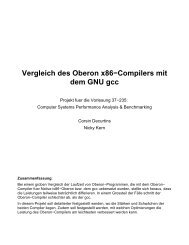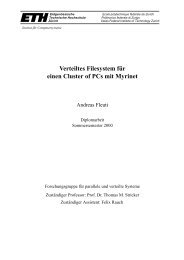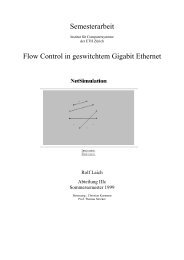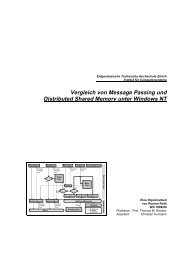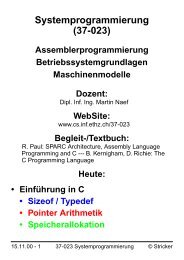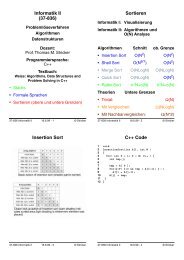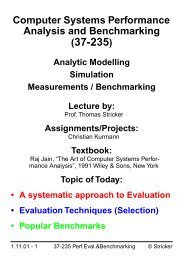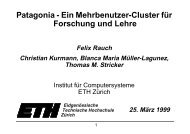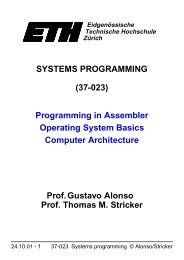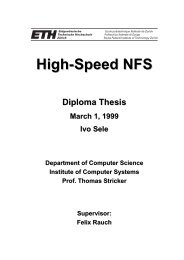serial communication controller (scc ™ sdlc mode of operation - Clips
serial communication controller (scc ™ sdlc mode of operation - Clips
serial communication controller (scc ™ sdlc mode of operation - Clips
You also want an ePaper? Increase the reach of your titles
YUMPU automatically turns print PDFs into web optimized ePapers that Google loves.
Application NoteSerial Communication Controller (SCC ): SDLC Mode <strong>of</strong> OperationRECEIVE INTERRUPTS ON SPECIAL CONDITIONS ONLYThe sequence <strong>of</strong> event in this <strong>mode</strong> is similar to that for“Receive Interrupts on first received character or SpecialCondition,” except it will not generate Receive CharacterAvailable interrupt at all. This <strong>mode</strong> is designed for<strong>operation</strong>s where the DMA is pre-programmed, or theapplication does not have enough time to set up DMAtransfer on First Character interrupt.The SCC is placed in this <strong>mode</strong> by programming Bit D4-3<strong>of</strong> WR1 to 11. Once programmed in this <strong>mode</strong>, the SCCgenerates interrupts when Special Conditions occur. OnSpecial Condition (either End-Of-Message oroverrun/Parity error, if enabled), corrective action can betaken for that packet.The SDLC Frame Status Buffer (not available on theNMOS version) is very useful in this <strong>mode</strong>. First <strong>of</strong> all, setDMA to transfer several packets. The SDLC Frame StatusBuffer holds information which tells you how many byteswere in the received packet and reports whether or noterror conditions (overrun/CRC error/parity error) haveoccurred.The sequence <strong>of</strong> events in this <strong>mode</strong> is identical to the“Receive Interrupts on First Character or SpecialCondition” <strong>mode</strong> (Figure 3); Note 3, however, does notapply, and Note 4 should read as follows for this case:Note 4 in Receive Interrupts on Special Condition only<strong>mode</strong>:DMA request for data 81H. The DMA function <strong>of</strong> the SCCshould be enabled by this time frame.RECEIVING BACK TO BACK FRAME IN RECEIVE INTERRUPTS ON SPECIAL CONDITIONONLY MODE“Back to Back” frame means there are two framesseparated with only one flag — the closing flag <strong>of</strong> theprevious packet also acts as the opening flag <strong>of</strong> thefollowing packet. Receiving such packets is identical toreceiving a single packet, except that the sequence <strong>of</strong>events happens in a short time around the shared flag.Assuming SCC is running under Receive Interrupts onSpecial Condition only <strong>mode</strong> (under DMA Control), atypical sequence <strong>of</strong> events is shown in Figure 4. It isidentical to that used for “Receive Interrupts on SpecialCondition Only” <strong>mode</strong>, with the addition <strong>of</strong> anotherfollowing packet.Notes on Figure 4:1. DMA request data before 0FFH.2. DMA request for data 0FFH.3. DMA request for data 42H.4. DMA request for the first CRC byte. The SCC treatsthe CRC as data, since the SCC does not yetdistinguish a difference between CRC and data!5. DMA request for the second CRC byte. The closingflag is recognized two bit-times before the secondCRC byte is completely assembled in the ReceiveShift Register. As soon as it is transferred to theReceive Buffer, it generates a DMA request.6. This interrupt is EOF (End <strong>of</strong> Frame), a SpecialCondition Interrupt. This will not occur until the DMAhas read the 2nd CRC byte from the Receive Buffer.When it occurs the Receive Buffer is locked and nomore DMA requests can be generated until theReceive Buffer is unlocked by issuing the Error Resetcommand. Before this command is issued, all <strong>of</strong> thestatus bits required (e.g., the CRC error status) mustbe read, and the last two bytes read by the DMAdiscarded. The Enable Interrupt on Next ReceiveCharacter command must be sent to the SCC so thatthe next character (i.e., the First Character <strong>of</strong> the nextframe) will produce an interrupt. If this is not done, thecharacter will generate a DMA request, not aninterrupt.On unlocking the Receive Buffer after the EOFinterrupt, no initialization is required with respect to thereceiver. All characters have been removed by theDMA and the receiver is ready for the next frame.While the Buffer is locked the SCC can receive 2 7/8characters (8 bits/character) before there is a danger<strong>of</strong> the receiver overrunning. The only way that this canbe specified is by referencing it to the falling edge <strong>of</strong>the request for the last CRC byte. This time is a worstcase minimum <strong>of</strong> 33 bit-times (possibly more if thereare any characters with inserted zeros). As soon asthe Buffer is unlocked an additional 8 (minimum) bittimesbecome available because the top byte <strong>of</strong> theBuffer is freed up.7. DMA request for second CRC byte. This occurs whenthe EOF interrupt service routine has not disabled theDMA function <strong>of</strong> the SCC, and fails to read the dataafter unlocking the FIFO by issuing Error Resetcommand.8. DMA request for data 01H.9. MA request for data 03H.6-100



